EDITOR'S NOTE—This story, highlighting the emerging and eccentric world of street golf, first appeared in September 2023. With the 2024 Summer Olympics heading to Paris, we’re revisiting Associate Editor Drew Powell’s experience playing France’s first permanent street golf course, located just outside Paris.
• • •
Start at Gare du Nord, the bustling train station just north of the center of Paris. Take the “H” train three stops—about 15 minutes—and hang a quick right. Strutting down Rue Charles de Gaulle, give yourself 10 more minutes. Once you reach the Casino supermarket, in the center of Deuil-la-Barre, you know you’ve made it.
You’ve reached the most innovative new golf course to open recently. Don’t see it? How about that towering, elaborate fountain across the street, prominently marking the center of town? That’s your ninth hole. Or that three-story “Hôtel de Ville” with the French flag outside that you just passed? That’s City Hall, and yes, it’s your opening hole.
Here, golf is played on concrete, in the center of town. It’s street golf—or urban golf, depending on who you ask—and this is the first permanent street golf course to open in France.
I traveled to the Parisian suburbs to learn about this emerging sport and play a round with the course’s designer, Eric Nguyen Khac, who helped his three-man French team win the 2018 World Urban Golf Cup in Paris. Khac and the French squad edged Germany by one shot in the inaugural 10-country event.
Modern street golf emerged in the 1990s—notably in Germany and Mumbai, India—and has spread across Europe and into the United States in the decades since. In each city, the sport takes on slightly different forms. In Portland, Ore., street golfers play with tennis balls. In Mumbai, they use plastic golf balls. European street golfers play to various targets, ranging from garbage cans to town fountains, and the Mumbai contingent plays to more traditional holes cut in the ground. Still, street golf’s underlying attraction of providing an inexpensive and accessible way to play is universal.
Anil Mane first started playing slum golf, as he calls it, as a kid in the streets of Mumbai in the early ’90s. As a caddie at nearby Bombay Presidency Golf Club, Mane wasn’t allowed to play on the course for free. Bending the ends of metal rods to create “slum sticks,” gathering a few plastic balls and digging holes in the ground, Mane and the other caddies brought the course to the street, where they still hold money matches.
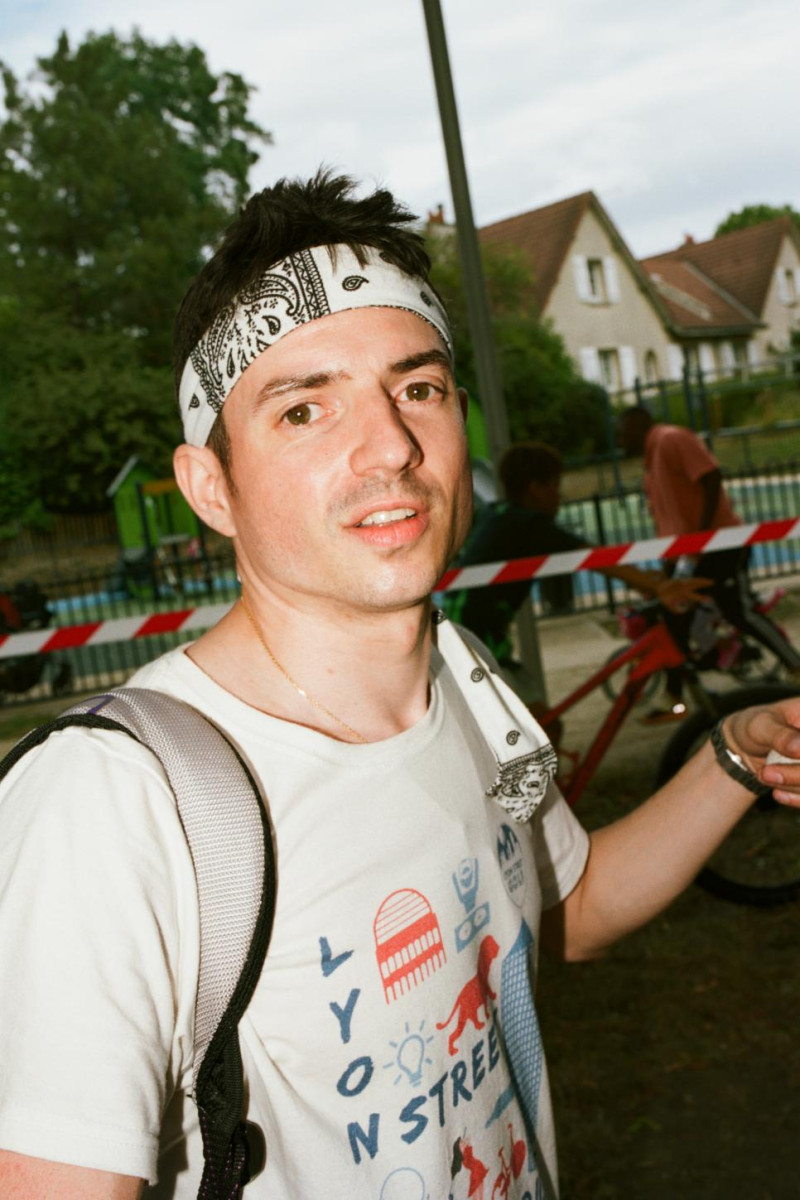
In the early 2000s, Portland’s Scotty Mazariegos was looking for “something out there, just a little bit different” to play with friends. He discovered street golf after reading about people playing in downtown London, and today, his group of several dozen regularly whacks tennis balls around Portland’s street golf courses—little more than pink duct-tape markings denoting the various holes, which range from light posts to garbage cans to broken-down cars. In another Portland street golf league—run by brothers Max and Drew Reinland, who own a streetwear clothing company called Muni Kids—as many as 100 people play every Thursday evening, opting for the softer foam balls as they compete on their nine-hole course.
In 2006, Mazariegos joined street golfers in Portugal and Paris to launch the World Urban Golf Day, when players from 17 cities in 10 countries all teed off in their respective cities at noon local time. Now an annual tradition in early September, World Urban Golf Day has players from up to 35 countries taking to the streets for a midday round.
Though I played collegiately at Duke, graduating in 2021, I had never played in the street. On the other hand, Khac has won a world championship in the urban sport but says his handicap in the traditional game is in the mid-20s. How would we stack up?
STREET GOLF’S UNDERLYING ATTRACTION OF PROVIDING AN INEXPENSIVE AND ACCESSIBLE WAY TO PLAY IS UNIVERSAL.
I met the soft-spoken Frenchman—who was sporting an orange hoodie and Vice Golf flat brim—around 10 a.m. just outside the Casino supermarket in Deuil-la-Barre, where the public can borrow a set of clubs for free. Khac, 59, has spearheaded the project, securing the city’s approval and designing the layout that plays in a three-kilometer loop around the center of town.
The only expense to play the course are the balls, which cost two euros each and are found in a gum-ball-like dispenser at the front of the store. Khac, who works as a creative director in advertising, says the candy dispenser was intentional.
“It’s a good symbol of street golf because it shows the accessibility of it,” Khac says. “It shows how everybody can play, including the children, and playing is like candy. It’s very playful.” Did I mention he works in advertising?
Placing the coin and turning the dial to get my “candy” in the form of a pink golf ball, I was eager to feel how it compared to a real ball. Of course, when playing in the street alongside cars and pedestrians, the ball must be uniquely soft and lightweight to avoid damage. The ball is designed to travel just one-third the distance of a traditional golf ball.
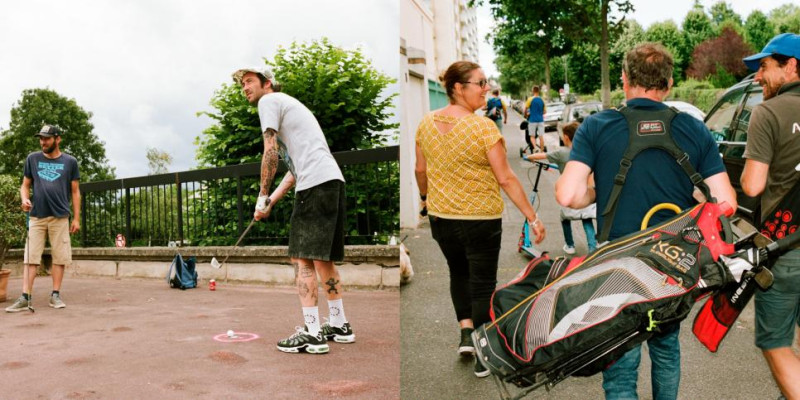
PLAYING THROUGH Intrigued Parisians often engage with street golfers to learn more about the sport.
Safety is the biggest question mark for newcomers. In fact, Mazariegos says that several street golf movements in the United States—in Florida, Seattle, Los Angeles and San Francisco—have fizzled out in large part because of police intervention.
In Portland and Deuil-la-Barre, however, city officials have endorsed the activity after concluding the balls pose few safety threats. After proposing the project to the city, Khac invited Deuil-la-Barre officials to play the course so that they could judge its safety. Khac made a few tweaks to the design based on their recommendations and was ultimately given the green light.
More From Golf Digest
 World's 100 Greatest Golf Courses
World's 100 Greatest Golf Courses
 Courses
Gil Hanse's new European course is part of a dream golf experience
Courses
Gil Hanse's new European course is part of a dream golf experience
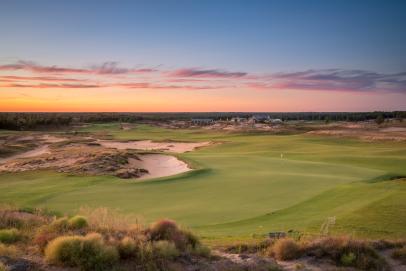 Our definitive ranking of the best states for public golf
Our definitive ranking of the best states for public golf
“My job was to design a course with maximum security,” he told me as we prepared for our round. “It was my guarantee to the city because I have 20 years of street golf experience. . . . Since July 2022 [when the course opened], we haven’t observed any problems—no accidents and no problems with the citizens.” Reassured that my sending a ball flying through the city streets wouldn’t land me in a French jail cell, we set off for the first tee.
Fittingly, the city-owned course starts adjacent to City Hall, where Khac designed a relatively straightforward opener. It’s a straightaway, 46-yard hole in which the objective is to get the ball to rest in the depression at the base of a tree, closely guarded by two other trees. The parking lot beyond is out-of-bounds and a one-shot penalty.
As I began to place the pink ball on the foot-wide circle denoting the tee, Khac stopped me. “Do you have a pencil to note the score? I need a reference score, and you’re a player,” he says. In addition to winning the 2018 WUGC with the French team, Khac was also part of the winning French team at the 2015 and 2016 European Cup. Yet the 20-year veteran of the urban sport was eager to test his skills against what he deemed a “traditional” golfer.
Smacking the concrete with his wedge, Khac sent a high, floating fade around the first tree, which landed surprisingly soft, kicked right and dropped in the hole.
“I’m a lucky man. The first time, for me,” he says with a smile after recording his first-ever ace on that hole. The champ came to play.
EUROPEAN STREET GOLFERS PLAY TO TARGETS RANGING FROM GARBAGE CANS TO TOWN FOUNTAINS.
Meanwhile, I was getting accustomed to (or attempting to, at least) the flight of the ball, which when properly struck has a soft, rising trajectory. Struggling with distance control, I was about three feet away from the tree in three shots. Khac glanced over, struggling to find the proper translation for the concession that is equally as common in street golf as in the classic game. “Gimme?” I offered. “Gimme,” he agreed with a smile.
Street golf requires many physical skills, namely distance control and accuracy on short pitch shots, but don’t underestimate the social aspect. As we approached the second hole, which plays to a trash can on the sidewalk, a woman was sitting on the bench just a couple feet away. Khac approached the woman and politely explained the situation. It turned out she had played the course before and, understanding the request, happily moved to a nearby bench. Fairway cleared.
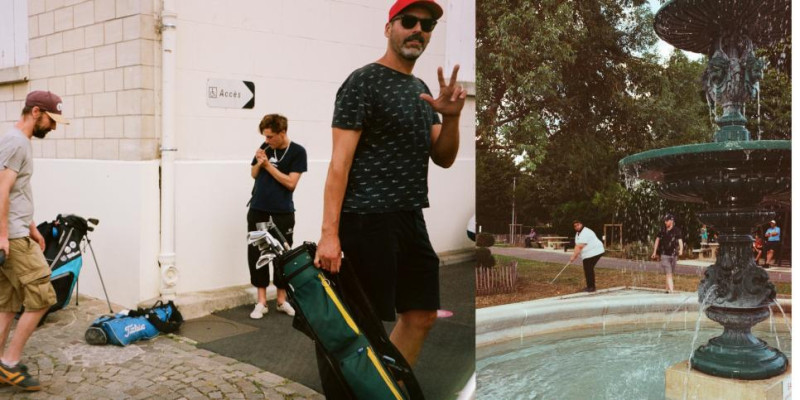
LOCAL KNOWLEDGE The best street golf courses offer players the opportunity to experience the city and its landmarks.
Though simply hitting the trash can is the objective at the second, if you get the ball to finish inside the narrow opening atop the three-foot-high structure, you get a bonus of minus one shot. Khac created these bonuses throughout the course to reward higher-level players and to provide risk-reward opportunities while maintaining playability for the beginner.
Opting not to go for the bonus, I faced a short, five-yard shot for a 3 and asked Khac if he recommended a putter or wedge. He grinned, replying “Personally, in street golf, it’s a little shameful to play with the putter.”
It seems akin to taking a putter from 20 yards off the green in the traditional game, and though I have been known to putt off dormant Bermuda fairways, I opted for the less shameful route—and missed.
Though I was off to an unspectacular start, it was evident that street golf holds many addictive qualities. It’s a sort of extreme mini-golf, open to everyone—all you need is a few euros and a short half-swing motion. It begs you to unleash your creative streak. Bounce it off the stairs? Sure, let’s see what happens. Curve it around a tree? Take your shot. The ball is easily maneuvered and can fly surprisingly far. I got about 100 yards out of a full swing, though most shots are short pitches.
Like mini-golf, there are rules for when your ball comes to rest against a wall, stairs, tree or other immovable object. Khac explained that you’re entitled to move the ball one grip-length at any time, effectively playing preferred lies everywhere.
Street golf is also an opportunity to experience the city and its landmarks. Just as golf-course architects design courses around a property’s defining features, Khac took a similar approach. “It’s important to be in different places that introduce the spirit of the city,” he says. “If you have a monument or a pretty place, it’s important that the course be on those places.”
On the Deuil-la-Barre layout, Khac delivered on that philosophy. The fourth and fifth holes play beside the city’s stadium and track, where kids were busy playing soccer. If Khac’s thoughtfulness in designing the course was not already evident, there are wood posts that mark each hole and explain the distance, rules and appropriate strategy. There is even a QR code on each post that leads you to the course website, which provides further guidance.
Khac designed another permanent course in Saint-Brieuc, located in Brittany, the peninsula in northwest France. When laying out urban courses, he identifies proper teeing areas, hole lengths and objectives to ensure the course is safe, playable for beginners and enjoyable for skilled players. His vision is to build more of these community courses around the suburbs of Paris to help popularize the accessible sport.
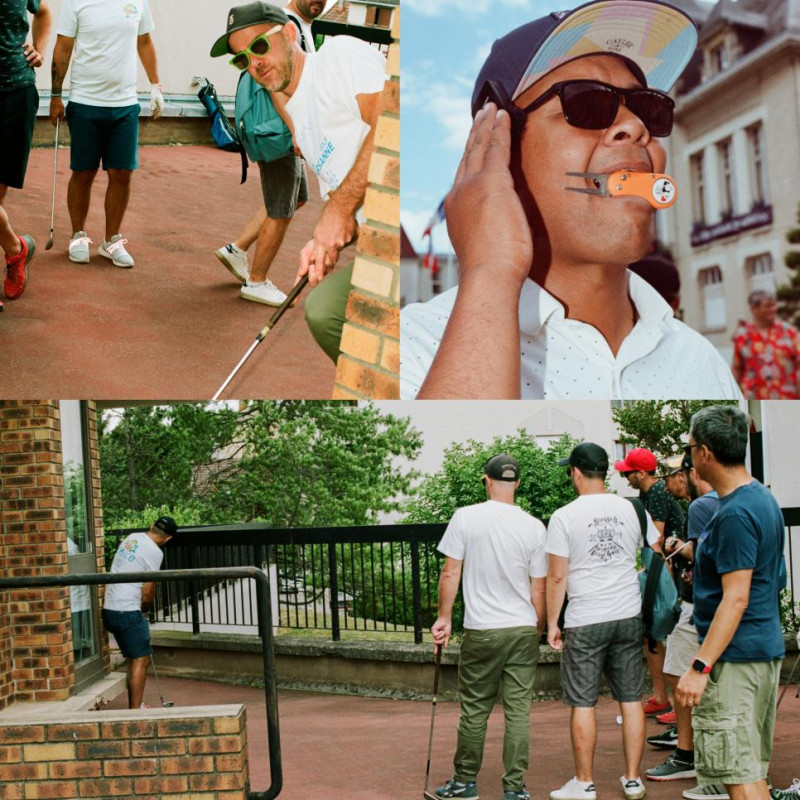
HARD KNOCKS The finals of the French Street Championship were played in Deuil-la-Barre, where the top three finishers qualified for the European Cup.
“We have to invent a new form of sport, and the new activity has to be in free access,” he says of street golf. “Activities in free access are ones that you can practice when you want.”
Off to a nice start, Khac relented slightly on the tricky dogleg-right sixth hole, which plays in a small park. His second shot ricocheted off the curb of the sidewalk and found the middle of a dense bush. You think you get bad breaks in traditional golf? They’re not just commonplace in street golf, they’re part of the intrigue.
The friendly match was the last thing on our minds, though, as Khac turned to me and uttered a mutual feeling. “I have a technical problem. I have to piss,” he says, looking around for a practical solution. In street golf, the solution is not as evident as when you’re shielded by thick forest. We continued.
Two hours after we started, we arrived at the picturesque finisher, our ninth hole, which plays adjacent to the town church and into the 10-foot-wide fountain in the city center. The objective is to simply hit the fountain, about 40 yards away closely guarded by a tree, but finishing in the water feature lands you the coveted bonus.
Trailing by one shot, I needed a hole-in-one if I was to catch Khac in this friendly battle. Narrowly skirting the tree and a friendly forward bounce later, I had my closing ace. If Khac’s first-hole heroics were any indication of how he would respond, we both knew what would happen next.
The tinted sunglasses, which Khac had on and off throughout the morning, were back on as if to add an extra layer of nonchalance as he calmly sent the ball into the fountain for the ace. It was a fitting ending that saw the world champion Frenchman defeat the American college golfer by one shot.
“My best score,” he said after completing the final tally and realizing it took him just 23 shots to get around his urban design. “You have the second-best score on this course,” he told me as mine added up to 24. I’ll take that consolation prize given my pedestrian start to the round.
Anyone playing street golf in downtown Deuil-la-Barre now has Khac’s course-record 23 as a reference score.